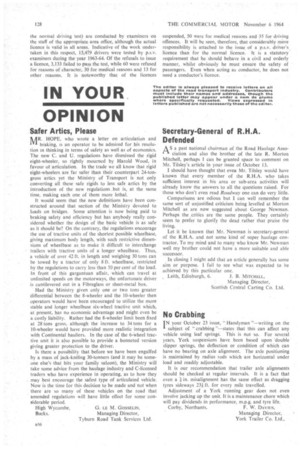MONEY MATTERS
Page 129

Page 130

If you've noticed an error in this article please click here to report it so we can fix it.
Well Done Dunlop!
UNFAILINGLY the results of DUNLOP RUBBER COMPANY are eagerly awaited not only by the motor cornponent section but by industrial equity sections generally of stock markets. Those for the half-year to end-June last exceeded the market's high expectations; they were, in fact, excellent. Sales increased by 121% to £153m. compared with the same period the year before. Of greater significance is the fact that pre-tax profit from these sales jumped by 30% to £8.53m., clearly pointing towards improved profit margins and greater efficiency of production. In the accompanying statement the directors comment that these increased sales and profits have, with few exceptions, been general right through the business of the group, both exports and home trade. As much as 60% of the total profit again stemmed from activities abroad. And there was encouraging news about the outlook; trade since June has continued at "a good level ", the board adds. But there is a warning that labour costs, both at home and abroad, are rising. Meantime, .the interim dividend is being lifted to 6d. per 10s. Ordinary share from the equivalent of 51d. per share and it will be paid on a capital made larger by the recent one-for-three scrip issue. It is a matter of no surprise whatsoever that the price of these shares is currently standing at their 1964 " high " point of 30s. 6d. ex div. At this figure they yield a useful 41% based on the latest assumed dividend of 13.7%. The market not only expects this rate to be improved upon in respect of the current year, but it regards these shares as a first-class purchase at around their present level. I couldn't agree more.
The results for the year to end-June last of SEDDON DIESEL VEHICLES are expected to be announced during the next few weeks. Trading profit for the 12 months to June 30, 1963 soared to £139,032 from £88,539 the previous year. Out of these sharply increased earnings the board lifted the dividend by 21% to 10%. Reviewing the year the chairman, Mr. H. Seddon, commented that the various departments were at that time more or less producing to "capacity ". Of importance to what the current year's results may be he added that this happy state of affairs would be maintained for some period of time ahead; the order book position ensured this. The buoyant state of trade in which this company is engaged should make possible another set of good results for the year to June 30, 1964. I shall be interested to see the degree of benefit (and there is almost certain to be some) derived from the decision to make the bodyworks into a separate subsidiary, thus enabling it to compete for bodybuilding on other makes of vehicles. At the beginning of last December the price of these Is. shares was 2s. 3d. That is their current price. An inhibiting factor to some investors taking an interest in them is the relatively narrow earnings cover of about 1-4 times. A further rise in profits, however, could clear away this inhibition.
Martin Younger journey or journeys made, as set out in the Road Traffic Act 1960, Section 118.
The term "separate fares " also covers not only what are generally understood as such—that is, where separate payments are made by individual passengers directly to the operator—but also in other circumstances. Thus, it covers arrangements in which separate payments for the journey are made, whether these payments are made to the owner of the vehicle or to any other person. Moreover, it is immaterial whether the payments are made solely in respect of the journey or not. A payment is regarded as made for the carriage of a passenger if it gives him the right to be carried whether for one or more journeys, or whether or not he actually travels.
Licences to drive a public service vehicle are normally valid for three years and cost 3s. Forms of application are obtainable from the offices of the Area Traffic Commissioners and tests of drivers (which are quite distinct from the normal driving test) are conducted by examiners on the staff of the appropriate area office, although the actual licence is valid in all areas. Indicative of the work undertaken in this respect, 15,479 drivers were tested by p.s.v. examiners during the year 1963-64. Of the refusals to issue a licence, 3,133 failed to pass the test, while 60 were refused for reasons of character, 30 for medical reasons and 13 for other reasons. It is noteworthy that of the licences suspended, 50 were for medical reasons and 35 for driving offences. It will be seen, therefore, that considerably more responsibility is attached to the issue of a p.s.v. driver's, licence than for the normal licence. It is a statutory requirement that he should behave in a civil and orderly manner, whilst obviously he must ensure the safety of passengers. Even when acting as conductor, he does not need a conductor's licence.












































































































































































